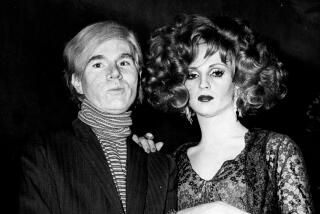Esther Williams, a ‘Bathing Beauty’ like no other
Even her dog could swim.
That’s one of my favorite memories from interviewing swimmer-turned-movie-star Esther Williams at her house in Beverly Hills in 1984. Williams, who died Thursday morning at the age of 91, was delightful talking about her fabled past at MGM. And of course her house had a pool — that’s where her little terrier would dog paddle.
Like many baby boomers, I grew up watching the former swimming champ’s vastly entertaining MGM Technicolor musicals like 1944’s “Bathing Beauty” and 1949’s “Neptune’s Daughter” on television, swooning over her extravagant, almost psychedelic swimming routines. They were gorgeous spectacles, and American audiences, weary from war, couldn’t get enough of them.
PHOTOS: Esther Williams | 1921 - 2013
In the water she was the real deal, statuesque and graceful, as natural in her element as a dolphin. And she wasn’t bad as an actress either, with a nice light touch for comedy — she could hold her own with such comedy wizards as Red Skelton and Lucille Ball and such singers and dancers as Gene Kelly, Frank Sinatra and Betty Garrett.
Her movies may not have been great art, but they were fun, escapist fare. Plots were secondary to the comedy, music and, of course, waterworks. MGM surrounded her with handsome leading men like Kelly, Van Johnson, Howard Keel and Ricardo Montalban; the studio’s top comics; and even opera singers like Lauritz Melchior.
FOR THE RECORD: An appreciation of Esther Williams in the June 7 Calendar section said that MGM’s “Ben Hur” was released in 1926. The film came out in 1925.
Williams, who hailed from Inglewood, arrived in Hollywood at a time when studios had great success turning athletes into movie stars. Olympic swimming champ Johnny Weissmuller became a superstar in the 1930s in MGM’s “Tarzan” features, while Olympic swimming sensation Buster Crabbe headlined Universal’s “Flash Gordon” serials. And 20th Century Fox turned Norwegian Olympic figure skater Sonja Henie into one of its leading musical comedy stars.
Nowadays top athletes find work on reality shows, but back then Hollywood had bigger things in mind for them. Studios carefully groomed their budding stars in those days, and once MGM figured out what it had in Williams they did everything — including building her a swim tank — to make her a pop culture icon.
Williams was a top swimmer, but sadly she never got to participate in the Olympics. By age 16, she had earned three national championship titles in freestyle and breaststroke and had made the 1940 Olympic team only to have the games canceled because of World War II.
HOLLYWOOD STAR WALK: Esther Williams
In a story that seems like a plot from a Hollywood film, Williams became a part-time model. One of her photos attracted the attention of theater impresario Billy Rose, who cast her with Weissmuller in his Aquacade show at the San Francisco’s World Fair. That’s where she caught the attention of an MGM scout who brought her to the studio where she filmed her screen test with the studio’s biggest attraction, Clark Gable.
Williams was an overnight sensation; she swam her way through a decade of MGM musical comedies in the 1940s and ‘50s. With her fresh-faced girl-next-door appeal, Williams quickly rose up the ranks at the studio. In fact, during the production of the 1944 Technicolor musical comedy “Mr. Coed” something extraordinary happened: The movie was transformed from a Skelton comedy into a starring vehicle for Williams and retitled “Bathing Beauty.”
Williams had only made two films before “Bathing Beauty.” But they were high-profile projects — the 1942 “Andy Hardy’s Double Life” with Mickey Rooney and Victor Fleming’s 1944 hit “A Guy Named Joe” with Spencer Tracy and Van Johnson.
With “Bathing Beauty” MGM pulled out all the stops, building her a tank at Stage 30. The film’s finale is a surreal extravaganza with William, replete with smoke, flames, fountains and dozens of synchronized swimmers.
“Bathing Beauty” was such a hit that it was the studio’s third-highest grossing film to date after 1925’s “Ben Hur” and 1939’s “Gone With the Wind.” Williams soon became known as “America’s Mermaid.”
Though audiences clamored for those elaborate swimming sequences, Williams proved she was a deft comedian and held her own as a singer and dancer. For 10 years she was one of MGM’s top moneymakers.
Unfortunately, when the audience’s appetite for musicals dried up in the mid-1950s, Williams’ career tumbled. She went dramatic in 1956’s “The Unguarded Moment,” but by the early 1960s she retired from acting.
Thankfully, most of her classics are available on DVD. TCM just announced a 24-hour Williams movie marathon on June 13. It will be a pleasure to dive back in.
PHOTOS AND MORE
VIDEO: Upcoming summer films
ENVELOPE: The latest awards buzz
PHOTOS: Greatest box office flops
More to Read
Only good movies
Get the Indie Focus newsletter, Mark Olsen's weekly guide to the world of cinema.
You may occasionally receive promotional content from the Los Angeles Times.







